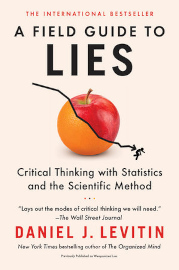A Field Guide to Lies: Critical Thinking with Statistics and the Scientific Method comes close to serving as a replacement for one of my all-time favorite books, How to Lie with Statistics, which was written in 1954 by Darrell Huff. Both books aim to alert their readers to the misuse of statistics and other methods for distorting truth.
Daniel Levitin, author of A Field Guide to Lies, borrows a few elements from Huff's book, including the use of humor to get ideas across. This is a feature you don’t expect to find in a book with such a title. For instance, in discussing ways that people make false correlations, he uses a spurious example found on several websites—a graph showing that the number of people who drowned by falling into a pool from 1999 to 2009 correlates very closely with the number of films in which Nicolas Cage appeared. Among the possible conclusions that could be drawn are “[D]rownings cause the release of new Nicolas Cage films” and “[T]he release of Nicolas Cage films causes drownings” (p. 49). Much of the humor is subtle; it hits you after you’ve read through several paragraphs and reached the “Ah ha!” where you recognize the absurdity of a “truth” claim.
Part One
The book is divided into three parts: Evaluating Numbers, Evaluating Words, and Evaluating the World. The first section bears the most similarity to How to Lie with Statistics, and as I read through it, I thought I had found the perfect replacement for the original book. In discussing how “numbers” are used to mislead people, Levitin uses many examples based on either actual or fictional advertising and news reporting. He discusses how misleading “averages” can be and has an entire chapter on how numbers are collected for surveys and the many potential pitfalls.
Part Two
Part Two: Evaluating Words has some excellent information, especially the chapter on “Overlooked, Undervalued Alternative Explanations.” Here, Levitin points out people’s tendencies to accept explanations at face value, especially if they hear the same explanation several times. He also notes that people tend to cherry-pick information that supports their own views.
This book was published in 2016, and if it had been written post-COVID, Levitin might have changed the title of one chapter in this section from “Counterknowledge” to “Disinformation,” and it could have been loaded with current examples. I also ran into a few other instances where I suspect Levitin would have written things differently post-COVID. For instance, he discusses where to get accurate information, and he says, “The .gov site may be biased toward government interests, but .gov site can give you most accurate info on laws, tax codes, census figures, or how to register your car. CDC.gov and NIH.gov probably have more accurate information about most medical issues than a .com because they have no financial interest” (p. 138). Sadly, we now know that key employees of the NIH (National Institute of Health) DO have a financial interest in promoting some products and services over others, and their information is questionable.
In this section, Levitin introduces Bayes’ Rule as a visual and mathematical method for calculating conditional probabilities. (See freecodecamp.org/news/bayes-rule-explained/ for an explanation, but I think Levitin makes it even simpler to understand in his book.) He uses it in several instances in the last two parts of the book to work out conditional probabilities mathematically. Students who are strong in math might enjoy these applications, but I fear that some teens will grow weary of this form of mathematical/logical analysis.
Part Three
Part Three: Evaluating the World begins with a chapter titled “How Science Works” that stresses the value of science. Levitin credits science (and the scientific revolution) with having shaped “our culture, industry, and greatest ambitions...” (p. 181), and he seems to reflect ideas promoted by the scientific establishment and the medical profession, which is logical since he’s a neuroscientist and cognitive psychologist. He acknowledges that some researchers fake their research, make up data, or fudge things to fit their predetermined outcomes, but he generally believes that science and logic are our most dependable methods for arriving at truth. He provides many good examples but then gets muddled when talking about the probability of life forming by chance. He writes,
If you’re going to use spuriously obtained probability estimates to claim that past events didn’t happen, you’d have to similarly conclude that human beings don’t really exist: It’s been claimed that the chances of life forming on Earth is one in many billions. Like many examples of counterknowledge, this uses the language of science—in this case probability—in a way that utterly debases that fine language (p. 231).
But he doesn’t explain why this application of probability is wrong. He would likely point to the very existence of life as evidence that it had to have formed by chance since he doesn’t accept any other explanation—the logical fallacy he previously explained of overlooking other possible explanations. Some of my readers might also take issue with his insistence that there is no correlation between the rise in autism rates and the use of the MMR vaccine (p. 209).
Summary
While most high school students can read through A Field Guide to Lies on their own, I think it works best with some discussion and maybe some help with the Bayesian reasoning.
As I mentioned earlier in my review, I very much liked the first part of the book, but the second and third parts were sometimes problematic—harder for the average teen to get through and perhaps overly optimistic about the wisdom of science.









